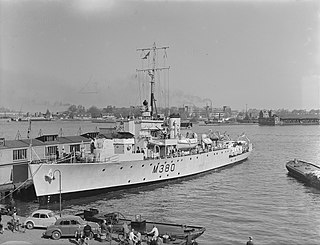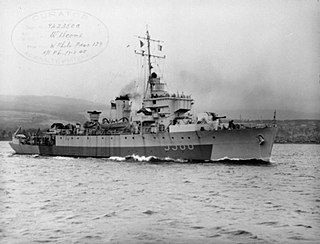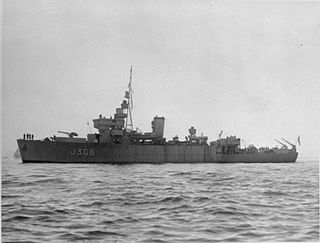
HMS Mariner was a reciprocating engine-powered Algerine-class minesweeper during the Second World War. Laid down as HMCS Kincardine for the Royal Canadian Navy she was transferred on completion to the Royal Navy as HMS Mariner. She survived the war and was sold to Myanmar in 1958 as Yang Myo Aung.

The Algerine-class minesweeper was a large group of minesweepers built for the Royal Navy (RN) and the Royal Canadian Navy (RCN) during the Second World War. 110 ships of the class were launched between 1942 and 1944.
HMS Ossory was a reciprocating engine-powered Algerine-class minesweeper built for the Royal Navy during the Second World War. She commissioned too late for service in the conflict, but was in service during the Cold War period. She was scrapped in 1959.

HMS Maenad was a reciprocating engine-powered Algerine-class minesweeper built for the Royal Navy during the Second World War. She survived the war and was scrapped in 1957.

HMS Hydra was a reciprocating engine-powered Algerine-class minesweeper built for the Royal Navy during the Second World War. She was badly damaged during the war and was scrapped in 1947.
HMCS Oshawa was a reciprocating engine-powered Algerine-class minesweeper built for the Royal Canadian Navy during the Second World War. Following the war, the ship was converted to an oceanographic research vessel and remained in this capacity until being scrapped in 1966.
HMCS Rockcliffe was a reciprocating engine-powered Algerine-class minesweeper built for the Royal Canadian Navy during the Second World War. Following the war, the ship saw service as training vessel before being scrapped in 1960.
HMCyS Vijaya, named in honor of Vijaya, the first king of Sri Lanka, was an Algerine-class minesweeper of the Royal Ceylon Navy, the first warship of that navy. Vijaya had been built as HMS Flying Fish (J370) for the Royal Navy during World War II, but was given to Ceylon by the United Kingdom upon the 1951 formation of Ceylon's navy.
HMCS St. Boniface was a reciprocating engine-powered Algerine-class minesweeper built for the Royal Canadian Navy during the Second World War. During the war, the vessel was used as a convoy escort in the Battle of the Atlantic. Following the war, the ship was sold for civilian use as a merchant vessel, last being registered in 1954.

HMS Providence was a reciprocating engine-powered Algerine-class minesweeper during the Second World War. Laid down as HMCS Forrest Hill for the Royal Canadian Navy she was transferred on completion to the Royal Navy as HMS Providence. She survived the war and was scrapped in 1958.

HMS Welcome was a reciprocating engine-powered Algerine-class minesweeper built for the Royal Navy during the Second World War. She survived the war and was scrapped in 1962.

HMS Hound was a reciprocating engine-powered Algerine-class minesweeper built for the Royal Navy during the Second World War. She survived the war and was scrapped in 1962.
HMS Wave was a reciprocating engine-powered Algerine-class minesweeper built for the Royal Navy during the Second World War. She survived the war and was scrapped, in 1962.
HMS Minstrel (J445) was a reciprocating engine-powered Algerine-class minesweeper during the Second World War. She survived the war and was sold to Thailand in 1947 as HTMSPhosamton(MSF-1).

HMS Fly (J306) was a reciprocating engine-powered Algerine-class minesweeper during the Second World War. She survived the war and was sold to Iran in 1949 as IISPalang.

HMS Larne (J274) was a reciprocating engine-powered Algerine-class minesweeper during the Second World War. She survived the war and was sold to Italy in 1947 as Alabarda(F 560).

HMS Cockatrice (J229) was a reciprocating engine-powered Algerine-class minesweeper during the Second World War.

HMS Felicity (J369) was a reciprocating engine-powered Algerine-class minesweeper during the Second World War.

HMS Lennox (J276) was a reciprocating engine-powered Algerine-class minesweeper during the Second World War.

HMS Niger (J442) was a reciprocating engine-powered Algerine-class minesweeper during the Second World War.













